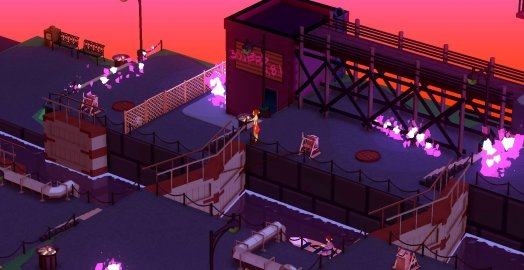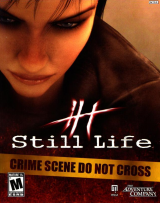Review for Fire Tonight

If you’re hipper than me, or perhaps just older, you might know of the band Information Society and their song “Fire Tonight.” Interpreted literally, it’s about two lovers trying to reach one another in a city going up in flames. “There’s a hot wind blowing tonight in the east, and I heard that the park is filled tonight with police,” goes the synth-pop tune. Developer Reptoid Games have used this as the basis for their shockingly short but gently entertaining game of the same name, but don’t worry if you’re in the same boat as me; while there may well be references that went over my head, no prior knowledge of the band or the song – which doesn’t actually feature in the game – is necessary.
Fire Tonight opens on a phone call between Maya and Devin, a young couple reminiscing about their past dates spent getting caught in the snow and shopping for cassettes. Suddenly the power goes out, and their chat is cut short. Maya hops onto her balcony to see that the transformer is on fire, so she sets out to find a payphone to call Devin back – this being the early 90s when the convenience of mobile phones was still unavailable. She finds a quarter and manages to get through, but the line is full of static, so she tells him to sit tight in his apartment and that she’ll find a way to cross the city and get to him.
The game alternates back and forth between both Maya and Devin, though you’ll spend most of your time with the former. Maya’s aim is to reach Devin, but she soon learns that the fire has mysteriously spread across the city, forcing her to take a circuitous route (and different modes of transport like her car and a train as far as they will take her) as she stealthily sneaks past police blockades protecting citizens from the flames, scrambles along rooftops, and climbs dumpsters to nip through alleyways.
Early on, Maya gains the ability to use her Walkman to play music that removes some of the flames and opens new routes – just roll with it, since there’s no real explanation for this power. The battery is limited, so you’ll need to scavenge for more to keep the power going, but they’re so plentiful that it becomes an unnecessary temporary progress staller rather than an interesting mechanic. You’ll also need to pick up keys you randomly find lying around to unlock gates, or time your movements so an officer’s flashlight doesn’t shine on you, but the path itself is obvious and the game is forgiving if you get caught (rewinding to a slightly earlier point). The penultimate level is entirely different and sees you weaving a roller-skating Maya through traffic. It’s a welcome injection of arcade action, though it only lasts for a minute or two.
You guide Maya from an isometric viewpoint, moving her with the keyboard or a controller’s left stick, pressing a key/button at the occasional hotspot to climb a ladder or talk to someone, for instance. The mouse/right stick is used to rotate the camera angle, which you’ll need to do so as a necessity to see where you’re going. I really wish it had been used as a fun way to integrate puzzles, however, in the way that other isometric games like FEZ harmoniously blended presentation and gameplay. It would have been much cooler to have to position the camera in a particular way to reveal a hidden message or to remove some obstacle or create a pathway. Though it’s helpful to be able to view everything from whichever angle you want, I basically kept the camera fixed until Maya went around a corner and out of sight, which made me wonder what the point of the manual control was.
Sometimes Maya will bump into someone and have a quick chat with them, like a police officer guarding the street or a local shop owner. These exchanges are charming and light-hearted; the officer shines his torch under his face and explains that ghosts have caused the roadblock, and the storekeeper blames the fire on kids using fireworks they got from him. There are no dialogue trees, nor do these characters specifically assign you tasks, but the encounters add a bit of spice to the proceedings. It would have been nice to have more conversations like these, with voice acting to match, since the writing is breezy and fun.
Devin’s much quieter segments opt for point-and-click gameplay in its most basic form, taking place entirely within his single-room apartment with no puzzle solving, inventory, or the like. Though you can still move the camera, you don’t control Devin. Instead you control a cursor while he remains in place, usually relaxing on the sofa. With a lonely pot plant in the corner (his “pet” from Maya), records and VHS tapes lining the shelves, and band posters adorning the walls, Devin lives simply but he seems content. As you move your cursor around the room, some items will outline in yellow, which you can click to get Devin’s thoughts until you’ve seen everything and the game moves on.
These sections are slight, but they make for a nice palette cleanser thanks especially to Devin’s gentle humour. At one point, he ponders about going out to find Maya, just in case she’s been trapped under a bus … but he decides against it because he “could never lift a bus.” Another time he considers wearing his roller skates full-time in place of his shoes so he can always be practicing his moves.
While I welcomed the chance to experience the same crisis from two different viewpoints, there’s certainly no innovation in the gameplay for either character. This isn’t necessarily a bad thing, but there’s nothing here that loads of other games haven’t done far better. Ultimately the challenge is slim. The only time I felt mildly tested was during a part with Maya where I had to pre-plan my route: lining up dumpsters to climb over fences to take the quickest path, opening gates on a timer, and then making a run for it before they closed. Even if you fail to navigate the route quickly enough, though, you can immediately have another crack at it.
Fire Tonight’s cartoony graphics are simple and do the job, though they lack the pizazz that would have made them memorable. Many of the city streets Maya roams look the same due to the generic buildings and reuse of elements like vehicles, trees, and streetlights. You often end up on rooftops, which are barren except for the occasional vent or chair. You’ll breeze through these locales anyway, so you won’t necessarily tire of them, but it’s a shame they don’t look more inspired. It might have been smart to push the design into a more fantastical sphere, considering the inexplicably pink flames breaking out all over the city. Nevertheless, the fact that everything is bathed in a night-time blue and purple light creates an alluring aesthetic.
Occasionally the story is presented via colourful 2D animation, and it’s a treat every time because it’s here that the visuals really shine. The drawings are expressive, doing a good job of contrasting Maya’s feistiness against Devin’s more laidback nature. The opening vignette is the longest example, but there are other brief comic-book-style cutscenes sprinkled throughout. Dialogue is also accompanied by static overlays of character art with changing poses and expressions. I would have liked to see more of these cartoony interludes, because they really imbue the experience with a sense of personality.
For a game inspired by a song, it’s unfortunate that there isn’t more musical inspiration. Maya’s segments are accompanied by upbeat, jazzy electronic tracks, reminiscent of the synths from the titular Information Society tune. They’ll keep you bopping in the moment and suitably match the chaos of her situation. The problem is that the limited tracks sound similar and loop endlessly to the point that they begin to lose their value. However, a nice touch is when Maya activates her Walkman (which you can enable and disable at will, providing you have battery power) and the score skids to a snail’s pace, like you’re entering some alternate reality. Devin’s apartment is accompanied by slow and gentle guitars; not something you’ll be humming afterwards, but it works to complement his more relaxed surroundings.
But here’s the big kicker of Fire Tonight: you’ll be done and dusted within an hour. That means it doesn’t outstay its welcome, and as constructed it likely wouldn’t sustain a much longer experience anyway, but the downside is that you don’t spend enough time with the lead duo to really care whether they ultimately reunite. Sure, what we see of them is cute, but there’s no meat on the bones. The length is forgivable given the game’s budget price, but you’re bound to be left wanting anyway by the time the credits roll. If you’re in the mood for something a little different, you can pick it up, complete it in a single session, and you’ll likely have a fine time being charmed by the 2D art and humour, but don’t expect to be enthralled by the simple gameplay and uninspired level design before it winds up all too soon.


























